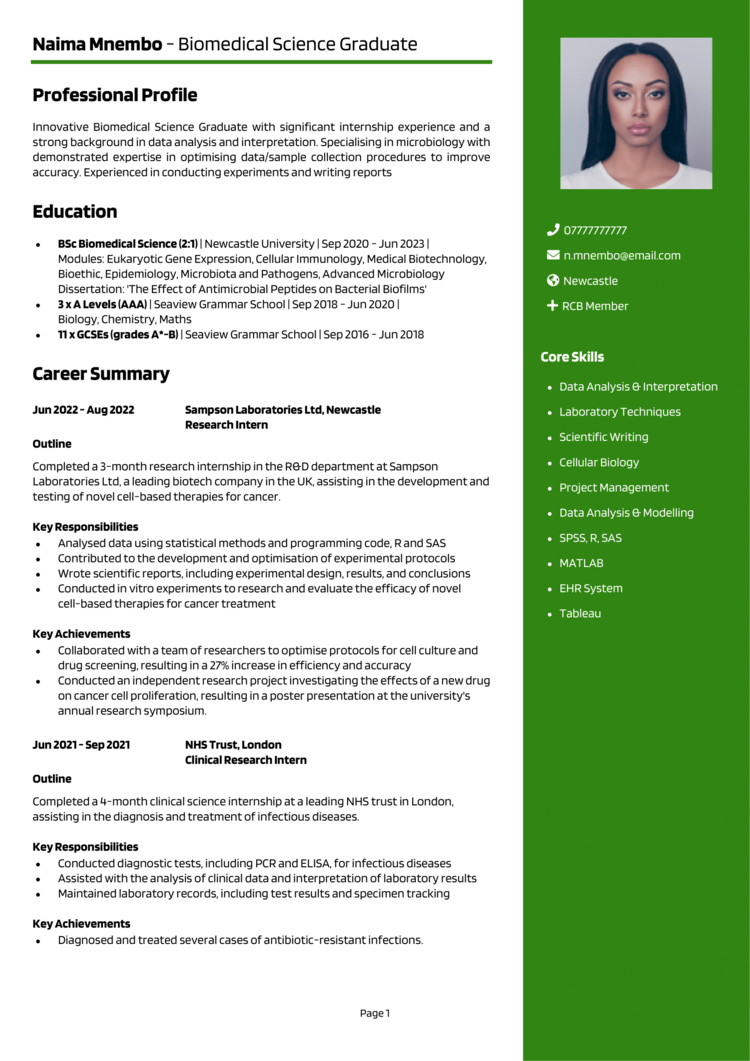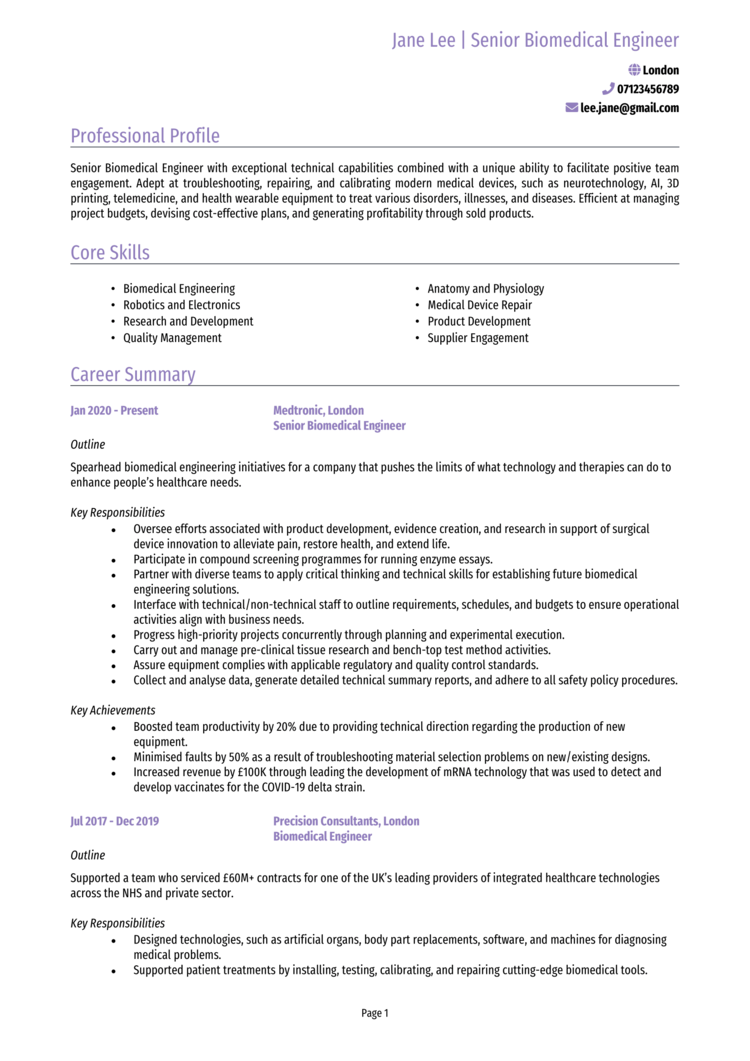From analysing blood samples to researching new treatments, you do the work that keeps medicine moving forward. But before you can land a rewarding new job, you need to put your own CV under the microscope.
This guide and its Biomedical Science CV examples will help you put together a CV that showcases your technical skills and research experience – so you can move from the lab bench to your next big opportunity.
Biomedical Science CV example

Biomedical Science Graduate CV

Biomedical Engineer CV example

How to write your Biomedical Science CV
Learn how to create your own interview-winning Biomedical Science CV with this simple step-by-step guide.
This step-by-step guide breaks down the essentials of writing a CV to produce a great biomedical science application – from structuring your experience effectively to ensuring your technical expertise stands out. Follow these steps and you’ll have a CV that’s ready for publication.
How to structure your Biomedical Science CV


A CV structure should be as clear and methodical as a well-documented research paper. If a recruiter has to sift through pages of irrelevant data to find your key skills, your application is likely to be shelved faster than an inconclusive experiment.
Here’s the layout to follow:
- Name and contact details – Place your name and personal details prominently at the top of your CV for quick access. Adding a photo is up to you.
- Profile – Open with a compelling overview of your key technical skills, experience, and the value you’d bring to a lab.
- Core skills – List your key abilities in this section, focusing on those that will be most relevant to the job, like data analysis and quality control.
- Work experience – Provide a detailed breakdown of your work history, starting with the most recent job first.
- Education – List your qualifications, including degrees and relevant certifications, in reverse chronological order.
- Additional info – Use this optional space for relevant hobbies, publications, or awards that enhance your application.
Biomedical Science CV format


A disorganised CV is like an inaccurate lab report – confusing and unlikely to get the desired results. Your format should be easy to follow and totally free from mistakes, to help recruiters find the things that make you the right candidate for the role.
Here are some useful tips on your formatting:
- Bullet points – Use short, sharp bullet points to present your responsibilities and achievements clearly.
- Divide sections – Make use of distinct headings and logical spacing to guide recruiters through your CV.
- Use a clear and readable font – A simple, professional font ensures readability while keeping the layout polished and tidy.
- No more than 2 pages – This gives you the length you need to detail your experience while keeping it concise enough to respect the recruiter’s time.
Biomedical Science CV profile


Your CV profile is your research abstract – an overview of your key expertise and career focus. This is the first thing any hiring manager is going to see, so make sure to hook them early with a quick summary. The ultimate aim is to convince them that hiring you would benefit their institution.
If it’s a more junior role you’re after, consider a longer personal statement instead – complete with a comprehensive cover letter.
Biomedical Science CV profile examples
Profile 1
Detail-oriented Biomedical Scientist with four years of experience in laboratory research and clinical diagnostics. Skilled in conducting tests, analysing biological samples, and ensuring compliance with laboratory safety protocols. Proficient in using advanced diagnostic equipment, including PCR, ELISA, and flow cytometry. Passionate about contributing to medical advancements and improving patient outcomes through accurate and efficient laboratory work.
Profile 2
Results-driven Biomedical Scientist with three years of expertise in microbiology and molecular biology, specialising in infectious disease research. Experienced in handling cell cultures, performing genetic analysis, and conducting immunoassays. Skilled in data interpretation, scientific reporting, and laboratory quality control. Dedicated to advancing healthcare through innovative research and diagnostic solutions.
Profile 3
Experienced Biomedical Scientist with over six years of expertise in clinical pathology, haematology, and biochemistry. Proficient in analysing blood, tissue, and fluid samples for disease diagnosis and treatment monitoring. Skilled in working with high-throughput laboratory equipment and ensuring compliance with ISO and GMP regulations. Committed to delivering high-precision test results to support medical professionals in patient care.
What to include in your Biomedical Science CV profile
These are the things you should aim to include in your profile:
- Biomedical specialisation – Whether you focus on microbiology, clinical diagnostics, or biotechnology, highlight your area of expertise.
- Technical expertise – Mention laboratory skills such as PCR, histology, or flow cytometry.
- Research contributions – If you’ve worked on published studies or significant research projects, include them.
- Analytical and problem-solving skills – Employers value professionals who can interpret data and troubleshoot scientific challenges.
- Regulatory and quality control experience – If you have experience in compliance with medical or laboratory standards, highlight it here.
Core skills section


Don’t force recruiters to use a microscope to find your key skills. They open your CV looking to see if you’re capable of the key tasks required in a lab, so make them clear in your core skills section.
If the role focuses on clinical diagnostics, highlight pathology, specimen analysis, and regulatory compliance. If it’s research-based, focus on laboratory techniques and data interpretation.
Skills to include in a Biomedical Science CV
- Laboratory Techniques – Conducting experiments using microbiology, molecular biology, and biochemistry techniques.
- Microscopy and Imaging – Using light and electron microscopes to analyse cell structures and tissue samples.
- Clinical Diagnostics – Performing tests on blood, urine, and tissue samples to detect diseases and abnormalities.
- Molecular Biology Techniques – Applying PCR, DNA sequencing, and electrophoresis for genetic and forensic analysis.
- Data Analysis and Interpretation – Evaluating laboratory results using statistical and bioinformatics tools.
- Immunology Testing – Conducting ELISA, flow cytometry, and antibody assays to assess immune responses.
- Quality Control and Assurance – Ensuring accuracy and compliance with laboratory protocols and regulatory standards.
- Histology and Pathology – Preparing tissue samples for examination and identifying abnormalities under microscopic analysis.
- Biomedical Research – Designing and conducting studies to explore disease mechanisms and medical treatments.
- Health and Safety Compliance – Following biosafety regulations, proper waste disposal, and ethical guidelines in lab work.
Work experience


Your past work experience should read more like a research portfolio than just a list of responsibilities. Employers want to see the impact of your work. Your experience section should highlight the research you’ve contributed to, the laboratory techniques you’ve mastered, and any improvements you’ve implemented.
List roles in reverse chronological order, ensuring each entry is structured with bullet points. If you’re new to the field, include internships, research placements, or university projects.
How to structure jobs

- Outline – Introduce the lab, research centre, or organisation you worked for, along with your role.
- Responsibilities – List key tasks, such as conducting tests, analysing samples, or running experiments. Use action words like “examined”, “analysed”, and “validated”.
- Achievements – If your experience section doesn’t include results, it’s like a study with no conclusions – hard to take seriously. Highlight measurable outcomes, such as research findings.
Work history examples for Biomedical Science
Biomedical Scientist | MediLab Diagnostics
Outline
Conducted laboratory tests and analysed biological samples at a medical diagnostics laboratory, assisting in the diagnosis and treatment of various diseases while ensuring accuracy and compliance with healthcare standards.
Responsibilities
- Performed haematological, biochemical, and microbiological tests on patient samples.
- Operated and maintained laboratory equipment, ensuring accurate and reliable test results.
- Followed strict laboratory safety protocols, including biohazard disposal and contamination prevention.
- Prepared detailed reports of test results for healthcare professionals.
- Ensured compliance with ISO and UKAS laboratory accreditation standards.
Achievements
- Reduced test processing times by 20 percent through workflow optimisation.
- Implemented a new quality control procedure, improving result accuracy.
- Recognised for contributing to the development of a new testing protocol for rapid disease detection.
Biomedical Scientist | GenTech Institute
Outline
Conducted molecular and genetic research for a biomedical research institute, identifying disease markers and contributing to medical innovation through advanced laboratory techniques.
Responsibilities
- Designed and conducted experiments using PCR, Western blotting, and ELISA techniques.
- Analysed genetic data to identify mutations and biomarkers for disease susceptibility.
- Maintained detailed laboratory records and prepared research reports for publication.
- Collaborated with cross-functional teams on clinical trials and research projects.
- Ensured compliance with laboratory safety standards and ethical research guidelines.
Achievements
- Co-authored a research paper on genetic markers in oncology, published in a peer-reviewed journal.
- Developed a new assay method that increased test sensitivity by 15 percent.
- Received recognition for contributions to a breakthrough in infectious disease diagnostics.
Biomedical Scientist | City Hospital Pathology Lab
Outline
Provided clinical laboratory support within a hospital pathology department, ensuring accurate and timely diagnostic testing to aid healthcare professionals in patient treatment and disease management.
Responsibilities
- Processed and analysed blood, urine, and tissue samples for disease diagnosis.
- Performed quality control checks on test procedures to ensure reliability.
- Worked closely with doctors and nurses to provide diagnostic insights for patient care.
- Trained junior lab technicians on proper sample handling and testing protocols.
- Managed laboratory inventory, ensuring the availability of critical reagents and supplies.
Achievements
- Increased lab efficiency by 25 percent through the implementation of automated testing procedures.
- Improved turnaround time for urgent tests, reducing delays in patient treatment.
- Recognised by hospital staff for maintaining high accuracy in test results.
What’s the best way to write an education section?


While work experience tends to be more valued, biomedical science is a field where education and academic qualifications are essential. As such, you’ll need to ensure your degree and any additional training are clearly listed.
If you’ve completed specialist courses in areas such as molecular biology, genetics, or bioinformatics, include them here to demonstrate your expertise.
Key qualifications for Biomedical Science roles
- BSc in Biomedical Science – The standard qualification for entry into the field.
- IBMS Accredited Degree – A must-have for those looking to work in NHS and accredited laboratories.
- MSc in Biomedical Science or a Specialised Field – Useful for advancing in research or clinical roles.
- HCPC Registration (UK-specific) – Essential for working in regulated biomedical roles.
- ISO 15189 Training – Valuable for professionals working in quality control and regulatory compliance.





